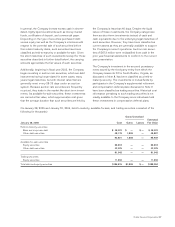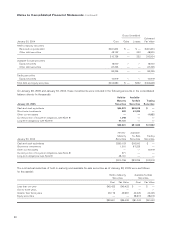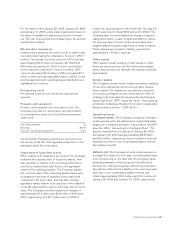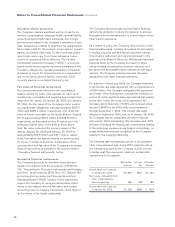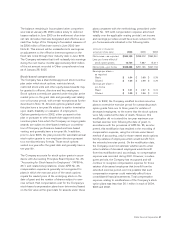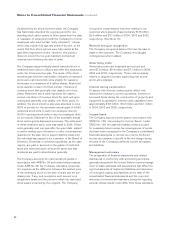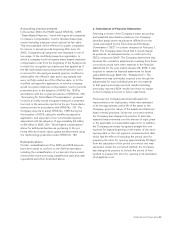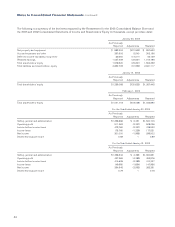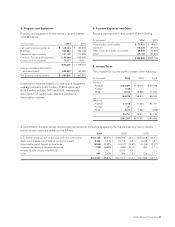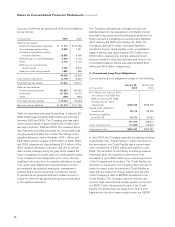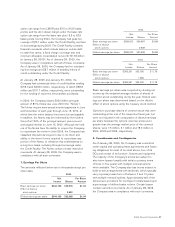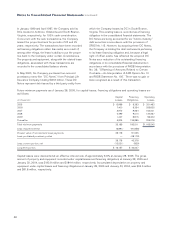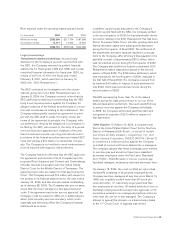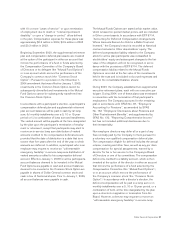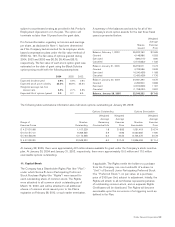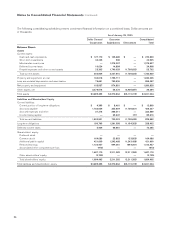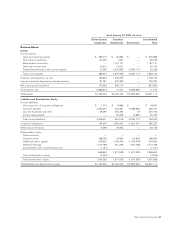Dollar General 2004 Annual Report Download - page 49
Download and view the complete annual report
Please find page 49 of the 2004 Dollar General annual report below. You can navigate through the pages in the report by either clicking on the pages listed below, or by using the keyword search tool below to find specific information within the annual report.
Dollar General Corporation 47
option can range from LIBOR plus 87.5 to 212.5 basis
points; and the all-in drawn margin under the base rate
option can range from the base rate plus 12.5 to 62.5
basis points. During 2004, the Company had peak bor-
rowings of $73.1 million under the Credit Facility, and had
no borrowings during 2003. The Credit Facility contains
financial covenants, which include limits on certain debt
to cash flow ratios, a fixed charge coverage test and
minimum allowable consolidated net worth ($1.39 billion
at January 28, 2005). As of January 28, 2005, the
Company was in compliance with all of these covenants.
As of January 28, 2005, the Company had no outstand-
ing borrowings and $8.7 million of standby letters of
credit outstanding under the Credit Facility.
At January 28, 2005 and January 30, 2004, the
Company had commercial letter of credit facilities totaling
$215.0 and $218.0 million, respectively, of which $98.8
million and $111.7 million, respectively, were outstanding
for the funding of imported merchandise purchases.
In 2000, the Company issued $200 million principal
amount of 85⁄8% Notes due June 2010 (the “Notes”).
The Notes require semi-annual interest payments in June
and December of each year through June 15, 2010, at
which time the entire balance becomes due and payable.
In addition, the Notes may be redeemed by the holders
thereof at 100% of the principal amount, plus accrued
and unpaid interest on June 15, 2005. Although the hold-
ers of the Notes have the ability to require the Company
to repurchase the notes in June 2005, the Company has
classified this debt as long-term due to its intent and
ability, in the event it were required to repurchase any
portion of the Notes, to refinance this indebtedness on
a long-term basis, including through borrowings under
the Credit Facility. The Notes contain certain restrictive
covenants. At January 28, 2005, the Company was in
compliance with all such covenants.
7. Earnings Per Share
The amounts reflected below are in thousands except per
share data.
2004
Net
Income Shares
Per Share
Amount
Basic earnings per share $344,190 329,376 $1.04
Effect of dilutive
stock options 2,692
Diluted earnings per share $344,190 332,068 $1.04
2003
Net
Income Shares
Per Share
Amount
Basic earnings per share $299,002 334,697 $0.89
Effect of dilutive
stock options 2,939
Diluted earnings per share $299,002 337,636 $0.89
2002
Net
Income Shares
Per Share
Amount
Basic earnings per share $262,351 333,055 $ 0.79
Effect of dilutive
stock options 1,995
Diluted earnings per share $262,351 335,050 $ 0.78
Basic earnings per share was computed by dividing net
income by the weighted average number of shares of
common stock outstanding during the year. Diluted earn-
ings per share was determined based on the dilutive
effect of stock options using the treasury stock method.
Options to purchase shares of common stock that were
outstanding at the end of the respective fiscal year, but
were not included in the computation of diluted earnings
per share because the options’ exercise prices were
greater than the average market price of the common
shares, were 7.3 million, 5.1 million and 18.3 million in
2004, 2003 and 2002, respectively.
8. Commitments and Contingencies
As of January 28, 2005, the Company was committed
under capital and operating lease agreements and financ-
ing obligations for most of its retail stores, four of its
DCs and certain of its furniture, fixtures and equipment.
The majority of the Company’s stores are subject to
short-term leases (usually with initial or primary terms
of three to five years) with multiple renewal options
when available. The Company also has stores subject to
build-to-suit arrangements with landlords, which typically
carry a primary lease term of between 7 and 10 years
with multiple renewal options. Approximately half of the
stores have provisions for contingent rentals based upon
a percentage of defined sales volume. Certain leases
contain restrictive covenants. As of January 28, 2005,
the Company was in compliance with such covenants.


